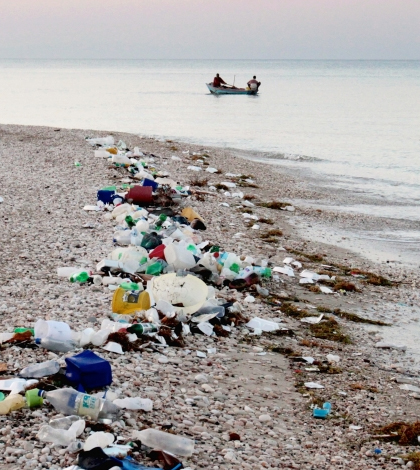Estimated 8 million metric tons of plastic enter oceans annually

A study by scientists at the University of California, Santa Barbara estimates that 8 million metric tons of plastic enters the oceans each year from land, according to a release. In addition to working to quantify the amount of plastic that washes into oceans in the work, researchers also provide a roadmap for developing solutions to the problem.
“Using the average density of uncompacted plastic waste, 8 million metric tons — the midpoint of our estimate — would cover an area 34 times the size of Manhattan ankle-deep in plastic waste,” said Roland Geyer, associate professor of environmental science and management at UC Santa Barbara, in a statement. “Eight million metric tons is a vast amount of material by any measure. It is how much plastic was produced worldwide in 1961.”
Part of the plastic problem is owed to a lag between proper waste management practices that didn’t begin until the 1970s, according to a release from the University of Georgia, which had experts contributing in the research. Around that time, the issue of plastic pollution was also first noted as a concern in scientific literature.

Infographic showing plastic waste inputs from land going into the ocean in 2010. (Credit: Lindsay Robinson, University of Georgia)
“It is incredible how far we have come in environmental engineering, advancing recycling and waste management systems to protect human health and the environment, in a relatively short amount of time,” said Kara Law, research professor at the Sea Education Association, in a statement. “Nobody has had a good sense of the size of that problem until now.”
Researchers made the estimates by looking at debris entering the ocean from land, sea and other pathways. From there, they put together rough figures that they worked into models relating to each source of plastic. These revealed that mismanaging waste had become the biggest contributor of plastic, they found.
The models are useful in quantifying the issue, but also in helping to find its solutions, scientists say.
“We’re being overwhelmed by our waste,” said Law. “But our framework allows us to also examine mitigation strategies like improving global solid waste management and reducing plastic in the waste stream. Potential solutions will need to coordinate local and global efforts.”
These include steps like working to reduce plastic in the stream of waste that we generate, improving the infrastructure of waste management facilities to remove plastic, and increasing the plastic we catch before it gets into the ocean.
The study laid out the Top 5 countries responsible for plastic pollution in our oceans, according to Mother Jones: China is No. 1, followed by Indonesia, the Philippines, Vietnam and Sri Lanka. The full investigation is published in the journal Science.
Top image: Plastic pollution lines a beach. (Credit: Timothy Townsend)




0 comments